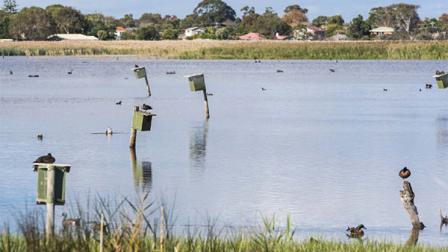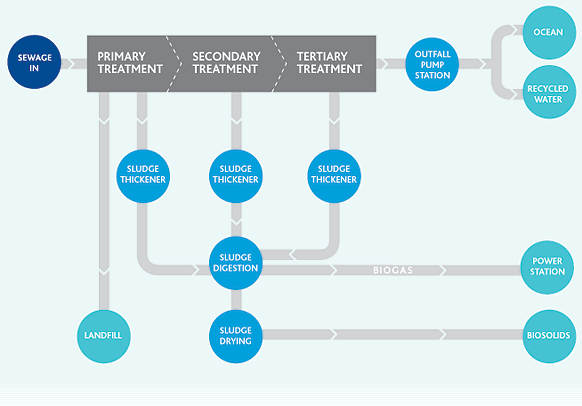Our treatment plant in the south-eastern suburbs uses innovative processes to turn sewage into Class A recycled water – learn more.
Facts about the plant:
- one-tenth the size of the Western Treatment Plant, but treats nearly half of Melbourne’s sewage: 400 million litres a day
- onsite the plant generates about 50% of the electricity needs from the following renewable sources:
- Biogas captured on site since it opened in 1975
- Solar farm constructed with 39,000 panels in 2023
- upgraded in 2012 to treat sewage to an advanced tertiary standard, producing Class A recycled water, for which it has won several international awards
Sewage treatment process
Sewage entering the plant goes through an intensive three-stage treatment process, which only takes 24 hours.
Primary treatment
Primary treatment physically removes pollutants from sewage.
It involves:
- using fine screens to filter out cotton buds, rags and other rubbish
- adding oxygen to so that fine particles like grit and sand float
- letting heavy items sink to form a layer of sludge, in a process called sedimentation
The sludge and floating debris is pumped to large tanks called digesters, where the temperature is controlled to help decomposition.
Secondary treatment
Secondary treatment uses different types of bacteria that live in different environments: with oxygen (aerobic), and without oxygen (anoxic). These break down organic material and remove nutrients.
The sewage then passes through sedimentation tanks called clarifiers, where more sludge settles to the bottom before being sent to the digesters. This leaves clear, treated water called secondary effluent, which flows on to large holding basins.
Tertiary treatment
Tertiary treatment disinfects the water. Treated effluent is pumped into the advanced tertiary treatment plant, where:
- ozone, generated on site, is added to disinfect the water and reduce colour and odour
- biological filters with helpful bacteria break down any remaining organic matter, oil, grease, foam, litter and solids
- ammonia is reduced to very low levels to make chlorine disinfection more effective, and minimise the impact on the environment where effluent is released
- ultraviolet light provides further disinfection
- chlorine is added for final disinfection.
Some of the treated water is then used on site or provided to nearby customers as recycled water. The rest is released into the ocean at Boags Rocks, under strict conditions set by EPA Victoria to protect the environment.
The sludge from earlier treatment stages is dried and stored in large piles, or reused as biosolids.
View an illustration of the key stages of the advanced tertiary process (202.08 KB, JPG)
Reporting odours
To report an odour you believe is coming from one of our sites, call us on 131 722 when you smell it so we can investigate in a timely way. Please do not submit odour reports online.
You may also like...
Biogas
We generate electricity by combusting biogas, captured from our sewage treatment lagoons and anaerobic digesters.

Edithvale–Seaford Wetland
Understand the importance of the largest natural wetland of its kind in Greater Melbourne, and how it is managed.

Be the first to know about new projects, ways to visit and opportunities to help shape the future of the site.
